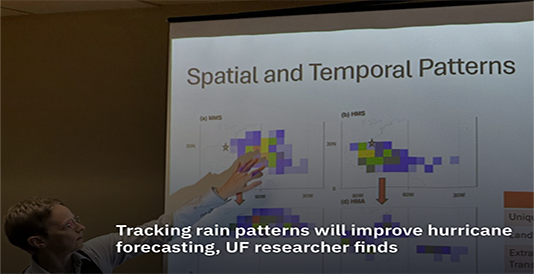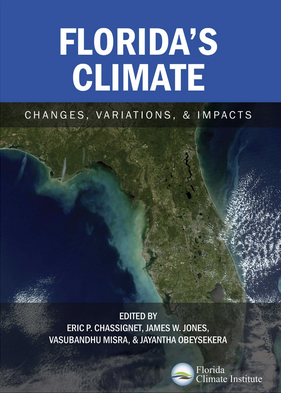Influence of the Atlantic Warm Pool on the Cimate of the Lesser Antilles
Contact Person: Misra, Vasubandhu
Collaborators: Misra, V.
Institutions: Florida State University
Funding Agency: USGS
Status: Funded
Abstract: The sustainability of a society and in this context of island nations is critically dependent on the fresh water availability. A significant source of the fresh water in these islands comes from precipitation. In this research we propose to study the rainfall variability of the Lesser Antilles in the late boreal summer-early fall (August-September-October [ASO]) season. Since most of the current global climate models are so coarse in horizontal resolution that these islands of the Lesser Antilles are not even resolved. As a result the interpretation of the predictions of say interannual variations of rainfall, surface temperature over these islands are based on the large-scale variations. There is however reason to speculate that there could be some local feedback mechanism such as that of the land-atmosphere interactions, or the influence of local orography that may influence the local climate, unresolved in the global climate models. This mechanistic study offers to first understand the role of the interannual variations of the surrounding oceans on the rainfall variations of the Lesser Antilles. This could lead to a possible insight to the behavior of the ASO rainfall in the Lesser Antilles in a warming climate. This study is investigating a possible source of predictability of the ASO seasonal rainfall variation from the slowly varying Atlantic Warm Pool (AWP) area. Furthermore, this study will also help us in understanding the influence on the Lesser Antilles ASO seasonal rainfall by the large-scale variations of the Sea-Surface Temperature (SST) in the tropical Atlantic Ocean at longer temporal scales of decadal variability and climate change signal. The research focus on the season of ASO assumes significance as it coincides with the annual peak of the Atlantic hurricane season. Therefore, as a consequence we will also be examining the impact of the interannual variations of the frequency and intensity of the extreme rain events from tropical storms on the local terrestrial hydrological budget. All of these research objectives are of great relevance to regional water managers, farmers, policy makers and to the tourism industry as all of these constituents are critically dependent on fresh water sources in these islands.
Contact Person: Misra, Vasubandhu
Collaborators: V. Misra, J.G. Morris
Institutions: Florida State University, University of South Florida
Funding Agency: UF/CDC
Start: September 2009 End: September 2013
Status: Funded
Filed Under: Climate Sciences, Human Dimensions
Abstract: In exploring links between climate change and human illness, significant attention has been given to the potential impact of such change on harmful algal bloom (HAS) populations and the illnesses that they cause. Among the various HAS-related human diseases, ciguatera has the greatest public health and economic impact, with recent studies from French Polynesia linking ciguatera incidence with increasing seawater temperatures: as such, ciguatera may serve as a key "sentinel" disease for global warming. We are proposing to build on the approach used in the South Pacific climate/ciguatera studies, but with a shift in focus to the Caribbean and "Caribbean ciguatera," taking advantage of our long-standing base for epidemiologic and environmental studies in the U.S. Virgin Islands. We hypothesize that climatic disturbances/disruptions of reef areas result in overgrowth of species of the dinoflagellate Gambierdiscus, with subsequent, and predictable, increases in fish toxicity and ciguatera incidence in endemic areas. To explore this hypothesis, we are proposing 1) to identify and characterize hospital and clinic-based ciguatera cases on St. Thomas and St. John; and to conduct cross-sectional surveys to develop accurate community-based estimates of disease incidence. As a second component of the study, we will monitor Gambierdiscus populations at sentinel sites around St. Thomas, looking at dinoflagellate distribution, abundance, and population structure; and collect data on toxin concentrations and structural diversity in dinoflagellates, locally caught fish, and fish/fish remnants implicated as the cause of ciguatera cases. Finally, we will seek to correlate weather patterns, including, in particular, the Atlantic Warm Pool, with prospective dinoflagellate population data, and prospective and retrospective disease incidence data; and to develop predictive models for occurrence of illness in human populations. The project explores the hypothesis that climatic disturbances/disruptions of reef areas result in overgrowth of species of the dinoflagellate Gambierdiscus, with subsequent, and predictable, increases in fish toxicity and incidence of ciguatera fish poisoning in endemic areas. The study will be performed on the islands of St. Thomas and St. John, U.S. Virgin Islands; data will be collected on ciguatera incidence, and on dinoflagellate populations implicated as the source of the toxins that cause the disease.
Contact Person: Jones, James W.
Collaborators: C. Fraisse, K.T. Ingram, J.W. Jones, J. O'Brien
Institutions: University of Florida, University of Florida State
Funding Agency: USDA RMA
Start: September 2002 End: September 2011
Status: Funded
Filed Under: Agriculture, Climate Sciences, Extension, Human Dimensions
Abstract: The overall goal of this program is to enhance and to improve the sustainability of the AgroClimate web-based tools that provide climate forecast information to producers and to provide risk management decision aids for use in the specified specialty crop commodities and forestry.
The specific objectives for this two-year continuation are:
- Develop an AgroClimate open source project and community of cooperators to enhance its sustainability and facilitate its adoption by other states.
- Develop tools, databases, and processes to update AgroClimate forecasts at a weekly or monthly frequency
- Analysis of North Carolina stakeholder characteristics
- Hold workshops in Florida, Georgia, and Alabama to better acquaint extension agents and farmers with the new AgroClimate and its tools
- Hold a final peer review panel to assess accomplishments
- Prepare final project report to RMA.
Contact Person: Martinez, Christopher J.
Collaborators: T. Borisova, N. E. Breuer, J.W. Jones, C. J. Martinez, D. E. Stooksbury
Institutions: UF, University of Miami, University of Georgia
Funding Agency: NOAA
Start: July 2010 End: June 2012
Status: Funded
Filed Under: Human Dimensions, Extension, Water
Abstract: The overall goal of this project is to provide an assessment of the current uses of, needs for, perceptions of, and attitudes towards weather and climate information, forecasts, and derived products by water resource managers in the states of Alabama, Florida, and Georgia, as well as to identify gaps in diagnostic and forecast information currently available. Water resource management systems in these three states vary in terms of size, complexity, institutional and regulatory constraints, infrastructure, and water source. This project will target large and midsized water resource managers in the three states and will increase our understanding of the issues and constraints to integrating forecasts into decision making, and the potential opportunities for providing custom-tailored, user-centric tools. Regional- and sector-specific assessment of users of such information is essential for providing custom-tailored information,tools, and decision support in the future. Based on preliminary survey results collected from water resource managers in the region, evaporation forecasts have been cited as one of the most desired products. In this project we will develop 1-14 day and monthly evaporation forecasts (with a forecast horizon of 9 months) using forecast analogs from the reforecast archives currently available for the National Centers for Environmental Prediction (NCEP) Global Forecasting System (GFS) and the Climate Forecast System (CFS). The analog forecasts will be downscaled to a resolution of 32-km using the North American Regional Reanalysis (NARR) dataset. The concurrent assessment of water resource managers and the development of forecast tools in this and other projects will provide an opportunity for feedback between scientists of the Southeast Climate Consortium (SECC) and end-users.
Contact Person: Jones, James W.
Collaborators: G. Baigorria, C. Fraisse, J.W. Jones
Institutions: University of Florida
Funding Agency: NASA
Start: October 2009 End: September 2012
Status: Funded
Filed Under: Agriculture, Climate Sciences, Extension, Human Dimensions
Abstract: The overall objective of this project is to adapt and apply state of the art climate modeling and remote sensing tools developed by NASA to enable partnering agencies to anticipate the effects of climate variability and change, including droughts and floods, on agricultural crop yields, and thereby to improve the management of risk in the context of agricultural productivity and sustainability.
To ensure the success of this overall objective, the following three specific objectives are defined:
- To expand the usage of climate model and mission product information about major climate variability systems (ENSO and the Arctic Oscillation [AO]) at both short-term (seasonal) and long-term (multi-decadal timescales) in DSSAT.
- To incorporate an end-to-end probabilistic approach beginning with changes in mean climate variables important to crop growth (such as surface air temperature and precipitation) and extending to yield projections and profit information from DSSAT.
- To integrate the impacts of projected changes in extreme climate events, as simulated by regional climate models driven by global climate models and validated by mission products into DSSAT in order to provide more complete and precise yield information and management options.
Opportunities
Funding
- Resilience: Vulnerability and resilience management for socio-environmental systems in exposed territories | October 17, 2025 (Pre-Proposals)
- NSF Atmosphere Cluster (AGS-AC) | ongoing
- NSF Geospace Cluster (AGS-GC) | ongoing
- Duke Energy Foundation | Ongoing

















